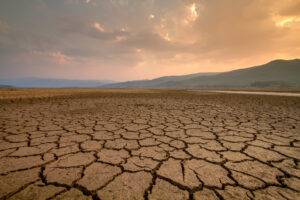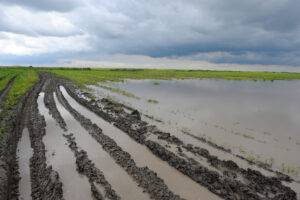
As climate change continues to de-stabilize our climate, it takes more awareness, skill, and preparation than ever before to avert weather-related setbacks. Extreme weather can ruin a lot of hard work and obliterate profits, but with some foresight and planning, you can build Plan B’s to help you and your hemp stay a step ahead when things get crazy outside.
And just to be clear before we start this discussion: we all know that not every disaster is avoidable. If a tornado passes over your field, there really aren’t any effective steps you’ll be able to take to ensure your plants don’t get torn up by high winds. But with slower-rolling weather events like droughts or too much precipitation, there are things we can do to mitigate catastrophic outcomes.
Let’s look at some seasonal threats and some ways that hemp farmers can take steps to maximize protection against them.
Pre-season choices
Before you plant, plot. As the hemp industry matures, hemp strain development has, too. Hybrids have improved immensely even in the five short years since the 2018 Farm Bill passed. That translates to hybrids that are stronger and more resilient to environmental extremes. It’s worth your time to investigate hybrids that are most likely to withstand your local conditions and order seeds from a reputable, established supplier. Success absolutely begins with the quality of your seed and this is one of the most important business decisions you can make.
Insurance
If disaster does strike, having the right insurance can be a real lifesaver. Yep. Obvious as it seems, make sure you speak to a trusted provider about the right level and type of coverage for your operation. The USDA has continued to strengthen crop insurance for hemp growers, making it a better value than ever. There are several programs available – most of them nationwide in the US. Agencies such as the Farm Service Agency (FSA), the Natural Resources Conservation Service (NRCS) and Risk Management Agency (RMA) all have programs to help hemp farmers manage their liability exposure. You can read more about it here.
Drought

Now that we’ve talked about two of the upfront “administrative” choices that you can make to skirt weather misfortunes, let’s talk about common scenarios that can wreak havoc with our crops. First up: drought. We can’t know what the weather has in store, but you CAN know what kind of soil you have. A percolation test is easy to do yourself, costs just about nothing, and will give you vital information about your soil’s water retention profile. Check out my March 2022 blog for instructions on the percolation test. Many, if not most, hemp growers have some kind of irrigation system, but supplemental practices can level up the efficiency of your watering, saving you money during prolonged dry periods. First, consider an autoflower hybrid. By planting autoflower strains that mature quickly with less water, you are improving the odds your plants can withstand dry days. For example, Pivot Auto-Flower is a popular high CBD strain we sell that produces fragrant buds in less than three months. Next, give your transplants lots of loosened soil to settle into. Substantial root systems are better able to seek and find moisture in the ground. Cultivate your grow area carefully so roots can easily spread out and penetrate deep.
If you live in a drought-susceptible area you may want to lay down plastic mulch over a drip irrigation network. This practice not only retains moisture, but controls weeds as well. Ironically, there have also been cases where crops were saved from excessive rains by plastic mulch that helped shed water away from roots. If you go with plastic mulch, I strongly advise reading up on plasticulture so you understand its complexities and best practices.
Flooding

Crops grown in low-lying areas and certain climates can be subject to seasonal flooding or long-term wet weather conditions. Too much water, as we all know, can lead to all kinds of problems with hemp plants, from root rot to moisture-loving fungi. There are systems you can put in place ahead of time that will help siphon off an overabundance of water. Depending on your field layout and its elevation relative to adjacent acres and waterways, a flood barrier may be what you need. Creating a weir with large rocks is one way to block, slow, or regulate a downstream flow that might otherwise breach its banks and flood your field. Installing drainage and possibly a pump system is another way to channel surplus away from crops and out into less destructive paths.
Planting in ridge rows elevates root systems above standing water or saturated soils. Strategically placed ditches can give water a harmless place to go where it can drain out and evaporate safely over time. Like just about everything in agriculture, any of these solutions will require ongoing maintenance, particularly dealing with built-up sediments. Whichever option you choose, know that it’s not going to be a once-and-done answer. Be prepared to monitor, maintain, and adjust your flood-management system over the long term.
Wind and hail

Wind burn can slow or halt hemp growth in the field and unfortunately, high winds are quite a common feature in some parts of North America. Not only is this dehydrating for row crops, it can also flatten and break plants, shred leaves and stems with airborne particulates and debris, and strip away trichomes. Structures that protect plants from wind are one of the most effective things you can do to lessen or prevent this kind of damage. Fences and wind break netting along your rows can moderate powerful gusts to livable levels. Alternatively, you can grow a living windbreak of sturdy shrubs to shelter your crops, but obviously this is a solution that will take some time. Some of you may be able to select planting locations that are near existing structures which can act as a shield against extreme winds. My final suggestion would be to look at hemp strains that are known to produce shorter plants; the lower profile of the plant can lessen wind impacts.
When it comes to hail, some of the solutions mentioned above for wind will afford a level of protection, however we all know that hail is in a category by itself when it comes to crop damage. Some farmers keep row covers handy in the aisles for just such a reason. There are plenty of local TV stations that tweet out hail warnings to subscribers, but even so, hail is notoriously a “surprise” event that can easily catch us off guard. As a practical matter, row covers may not be much help when large, hard balls of ice drop from the sky. I suggest assessing the risk level for your location and insure yourself accordingly.
Heat

Like windburn, heat stress can really mess with the health of your plants. There are three things that you can do to be prepared for heat waves that can potentially traumatize your crop and reduce yield. First – and not to sound like a broken record – but starting with a heat-tolerant hemp strain is one of your smartest choices. From the very start of the growing season, this automatically reduces risk related to long-term high temps. Strategically timed watering is a second tactic you can use to alleviate plant stress during a heat wave. By irrigating in the morning and/or evening when temperatures are cooler, you reduce evaporation loss that occurs when you water under a blistering noon-day sun. Furthermore, water droplets can magnify the sun’s rays and create burn spots on plant tissue. As a final suggestion, you can try supplements. Many growers have had success with seaweed and kelp extracts that can increase plant hardiness.

In the agricultural community, it’s not uncommon to hear farmers and growers talking about the weather in war-like terms, as if we get out there every day to “do battle” with Mother Nature. I personally feel that’s an unproductive way of looking at things. Negativity increases your stress level. If you insist on seeing weather as an enemy, it follows that you’re going to view yourself as a victim. That’s unhelpful. Instead, lean into the chaos a little. The weather is what it is. Sometimes great, sometimes disastrous. Farming is always a labor-intensive, risky enterprise – and it’s also one of the greatest and most fulfilling occupations. Understanding your most likely threats and preparing for them as best you can, will bestow you with a greater sense of control over your outcomes. It’s also oddly calming to know and be ready for the weather catastrophes that will inevitably – and rarely — ruin some of your hard work and put a dent in your bottomline. If you make a list of the most common destructive weather events in your area and have a plan of action for each one, I promise it will reduce your anxiety. Context is calming. Having a big-picture outlook that acknowledges occasional weather adversity is important for your mental health. Destructive weather is a blip, not the whole story. Having a strategy that accounts for occasional failures is the surest way to be successful long term and keep your head, and your bank account, in the right place.


Recent Comments